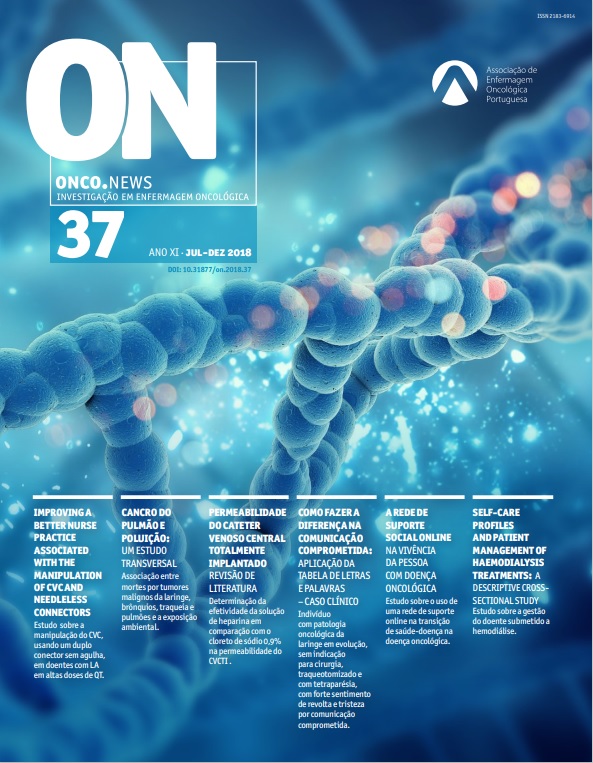Lung cancer and pollution: A cross-sectional study
Keywords:
Malignant tumors, Health, Environment, Anthropogenic emissions, Economic activityAbstract
Several studies have established a direct relationship between environment exposure and the development of certain cancer pathologies. The state of the environment is directly influenced, in part, by anthropogenic activities, which highlight the typology of economic activity in the area. Starting from an initial project, namely WeGIx - WellBeing Global Index - this article aims to:
Objectives: Establish an association between deaths due to malignant tumors of the larynx, bronchi, trachea and lungs and environmental exposure, namely PM10 , PM2,5 e NOx emissions, as well as to the type of economic activity allocated to the municipality, based on the typology of the territory - Predominantly Urban, Semi-urban and Predominantly Rural.
Material and Method: Observational and transversal study; statistical data for the year 2015 from the PORDATA and APA - Portuguese Environment Agency - of the Portuguese population resident in the 308 municipalities. Data analysis performed using IBM® SPSS® Statistics vs.24.0, considering a significance level of 0.05 for all statistical inference situations.
Results: The associations made reveal a statistically significant difference of means between the three types of territory with regard to mortality. The results show that the behavior of the independent variables - related to population characteristics, pollutant emissions and typology of economic activity – in relation to mortality – varies according to the type of territory - Predominantly Urban, Semi-urban and Predominantly Rural.
Conclusions: The study of the variables under analysis allows us to conclude that there is an association between deaths due to malignant larynx, bronchial, tracheal and lung tumors and the exposure of people to the environment, namely PM10, PM2.5 and NOx emissions. Regarding the typology of economic activity, as an element conditioned by the characteristics of the territory, the impact of its variability differs from the type of territory, consequently, influencing in a different way the vulnerability to death.
Downloads
References
Anenberg, S.C., Miller, J., Minjares, R., Du, L., Henze, D.K., Lacey, F., Malley, C.S., Emberson, L., Franco, V., Klimont, Z., and Heyes, C. 2017. Impacts and mitigation of excess diesel-related NOx emissions in 11 major vehicle markets. Nature, 545: 467-471.
Cepeda, M., Schoufour, J., FreaK-Poli, R., Koolhaas, C. M., Dhana, K., Bramer, W. M., & Franco, O. H. (2017). Levels of ambient air pollution
according to mode of transport: a systematic review. Lancet Pubic Health, pp. 23-34.
DGS. (2013). Portugal – Doenças Oncológicas em números – 2013. Lisboa: Direção-Geral da Saúde.
Greenbaum, D. S. (2013). Sources of Air Pollution: Gasoline and Diesel Engines. In K. Straif, A. Cohen, & J. Samet, Air Pollution and Cancer (pp. 49-62). Lyon: Internacional Agency for Research on Cancer (IARC) Publications.
Harrison, R. M., Hester, R. E., & Querol, X. (2016). Airborne Particulate Matter: Sources, Atmospheric Processes and Health (Vol. 42). The Royal
Society of Chemistry.
Hirabayashi Satoshi, Nowak, D. (2016) Comprehensive national database of tree effects on air quality and human health in the United States
Environmental Pollution 215: 48-57.
Ki-Hyun K., Pawan K., Jan E., Adedeji A.,Muhammad J., Minori U., Scott C. (2017).Toward a better understanding of the impact of mass transit
airpollutants on human health. J. Chemosphere: 268-279.
Office of Air Quality Planning and Standards Office of Air and Radiation, 1995. Chapter 3: Stationary Internal Combustion Sources, Section
3 Gasoline and Diesel Industrial Engines (1-9). AP 42, Fifth Edition Compilation of Air Pollutant Emission Factors. EPA - United States
Environmental Protection Agency, North Carolina.
Raaschou-Nielsen, O., et.al. 2016. Particulate matter air pollution components and risk for lung cancer. Environment International, 87: 66-73.
WHO (2016). World health statistics 2016: monitoring health for the SDGs, sustainable development goals. Suiça: World Health Organization.
Downloads
Published
How to Cite
Issue
Section
License
Copyright (c) 2018 Esmeralda Barreira , Manuela Pontes, Rui L. Maia, Gisela M. Oliveira, Diogo Guedes Vidal

This work is licensed under a Creative Commons Attribution-NonCommercial-ShareAlike 4.0 International License.




